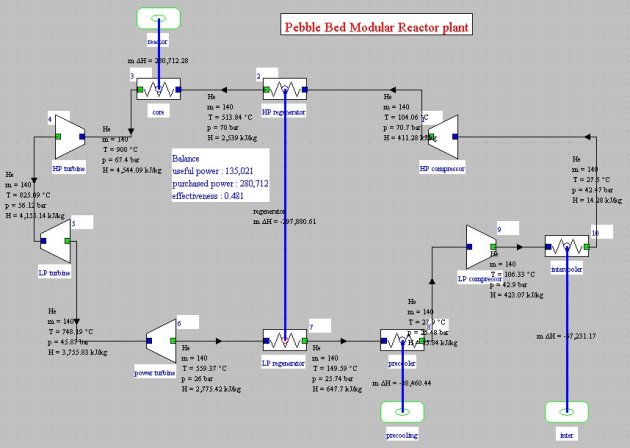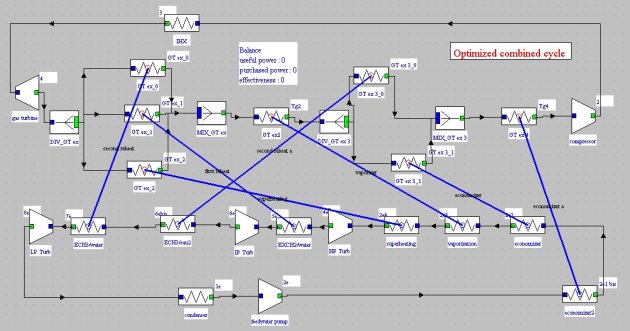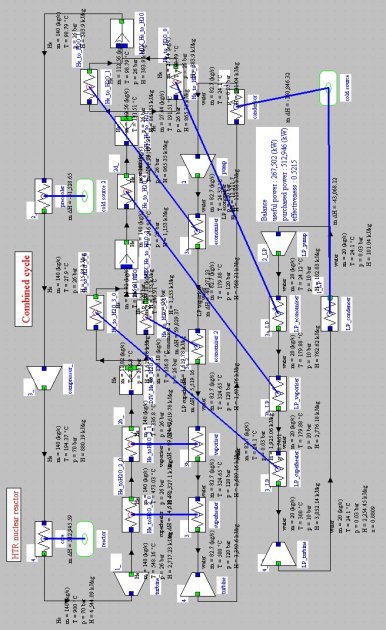High-temperature nuclear reactor cycles
High-temperature reactors that were studied in the years 1960–1970, including Germany and the United States, had the following characteristics:
fuel was packaged in the form of nuclei of oxide or carbide of uranium, plutonium or thorium, coated with pyrolytic carbon and silicon carbide supposed to prevent fission products from escaping from fuel spheres;
helium was considered as gas coolant in order to reach temperatures of around 800 °C for a high thermodynamic efficiency of 40%;
reactors were generally of the slow neutron type with graphite as moderator.
One of the advantages of these reactors is to significantly exceed temperature levels to which those using water are limited, which allows high conversion efficiencies to be considered.
Deux principaux types de réacteurs ont été étudiés au cours des dernières années, les cycles PBMR et GT-MHR, et un troisième, appelé VTHR est envisagé. Toutefois, si les réacteurs eux-mêmes diffèrent sensiblement, les cycles thermodynamiques qui peuvent leur être associés sont à peu près les mêmes.
Small capacity modular reactor PBMR
PBMR (Pebble Bed Modular Reactor) reactors are high temperature thermal neutron reactors with an output of 100 MW using pebbles of weakly enriched uranium fuel embedded in carbon (which plays the role of moderator) and using helium as coolant.
PBMR cycles theoretically have an excellent efficiency, close to 48%. However, their industrial production is hampered by various technological difficulties, particularly in terms of on-site review of the fuel, which means that real efficiencies are actually much lower. In addition, there is currently no high efficiency helium turbomachinery. Launched in South Africa in the early 1990s this concept was abandoned in 2002.
GT-MHR reactors
Studied by an international consortium led by General Atomics (USA), GT-MHR (Gas Turbine Modular Helium cooled Reactor) reactor is a modular thermal neutron reactor (300 MW units), helium-cooled, high-temperature, which can use various fuels (plutonium or enriched natural uranium, thorium) packed in silicon carbide beads. Differences between GT-MHR and PBMR are numerous, although they are both high-temperature helium cooled reactors.
The GT-MHR capacity is 300 MW, a compromise between the requirement of intrinsic safety, which involves reduced capacity, and economic competitiveness which requires economies of scale. As fuel, GT-MHR uses the same principle as PBMR, beads coated with millimeter fuel refractory beads by TRISO process. However, instead of being agglomerated in the form of pebbles, the balls are in the form of small cylinders of a few centimeters in height, the cylinders themselves being formed into fuel elements in graphite prismatic shape. This method allows a better knowledge of the location of the fuel and yields a higher unit power than for the PBMR. It also reduces by a factor of 5 to 10 the pressure drop in the reactor.
To control the chain reaction, the GT-MHR has control rods which may be supplemented by an injection system by gravity of boron particles. Moreover, in case of damage on these two active systems, designers made sure that the reactor can cool itself through a heat transfer by conduction to the tank walls, themselves water circulated. Finally, the concrete structure is supposed to absorb heat and transmit it by conduction in the surrounding basement, the reactor being buried. The GTMHR developers ensure that fuel temperature remains below 1,600 °C temperature limit for stability of materials used for making millimeter beads, including in case of reactor depressurization. GT-MHR is supposed to achieve a thermal efficiency of 48%. The refueling outages are scheduled every 18 months, with replacement of half the fuel elements.
Very high temperature reactors
Very high temperature reactor VHTR is in line with modular reactors type GT-MHR (thermal neutrons). It is distinguished by a much higher temperature, since the temperature of the coolant gas is expected to reach 1,000 to 1,100 °C.
VHTR reactor fuel is designed along the same lines as that of high temperature reactors, with a package in the form of millimeter beads agglomerated as cylinders inserted in fuel elements. VHTR should use helium as coolant, the temperature of gases leaving the reactor vessel reaching 1000 °C. A VHTR priority is that it can burn its fuel with a much higher efficiency than current reactors.
With high thermodynamic efficiency, VHTR would have a unit capacity of 600 MWe. VHTR was originally intended to burn essentially a mixture of highly enriched uranium and thorium. The objective today is explicitly that this reactor can not only burn low-enriched uranium, but also incinerate plutonium and plutonium mixed with some minor actinides. Contested by some experts, this capability would allow a resumption of PWR waste.
However, to successfully make them work, many technological problems must be solved, particularly the development of materials capable of withstanding very high temperatures.
New markets opened by VHTR should be multiple. Many industrial processes are indeed performed at high temperature: production of cement, glass, steel, coal gasification and thermochemistry.
However, given the inertia of industrial processes and hopes for developing alternative fuels for transportation, the main VHTR application would be hydrogen production.
Gas cycles
One of the most interesting gas cycles is the Brayton helium cycle with regeneration and staged compression and expansion:
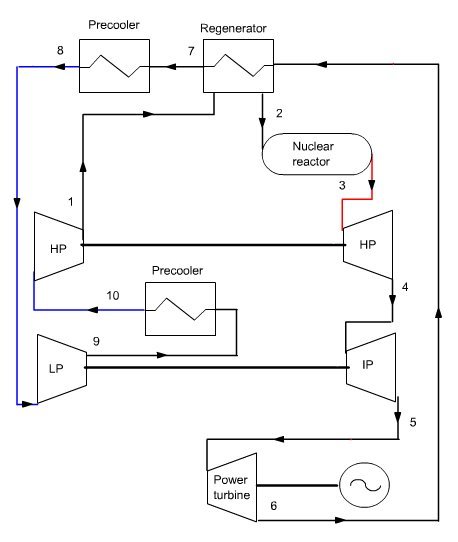
In the example shown in Figure below, a rate of 140 kg/s of helium is compressed to 70 bar (1), enters a regenerator, which it exits at 514 °C (2) before cooling the reactor core which it exits at 900 °C (3) and at 67.4 bar. This fl ow is expanded in a HP turbine (3–4) used to drive the HP compressor, before entering a second IP turbine (4–5), equilibrated with the LP compressor. Helium is then expanded at 26 bar and 559 °C in the LP turbine (5–6), which produces useful power. The cycle is closed by two step helium cooling (regeneration (6–7) and then cooling at about 28 °C (7–8)), followed by a two-stage compression (8–9) and (9–1) with intermediate cooling (9–10). In this example, turbomachinery polytropic effi ciency and regenerator effectiveness are assumed equal to 0.9, which partly explains the high efficiency (48%).
As stated above, such a cycle is however difficult to build, because there is currently no industrial experience on helium turbomachinery.
Supercritical CO2 cycles
Supercritical CO2 cycles have been proposed to replace HTR helium cycles.
HTR combined cycles, cogeneration
The GT-MHR reactor is the result of optimization work performed by General Atomics in 1985. Since 2000, Areva, which is involved in this work, changed the basic concept (helium Brayton cycle) so as to make the design easier and the adaptation to cogeneration more immediate (Gauthier et al., Gosset et al., 2005).
Example of the Areva concept
Considerations governing the selection of cycles are numerous. Obviously, intrinsic cycle efficiency is fundamental, but technological feasibility is not less. This has led Areva to choose for HTR-VHTR a combined cycle using a helium-nitrogen mixture (20–80 wt%) instead of pure helium, because of the considerable experience gained over several decades in air gas turbines.
In 2002, Areva optimized with Thermoptim a combined cycle associated with a HTR (Figure below). Variations of this cycle can provide superheated steam at 110 bar using water at 120 °C for some cogeneration applications, for capacities from 50 to 300 MW. The efficiency announced by Areva in electricity production is only 47%, but the objective is actually 50%, without any particular technological development except the IHX intercooler
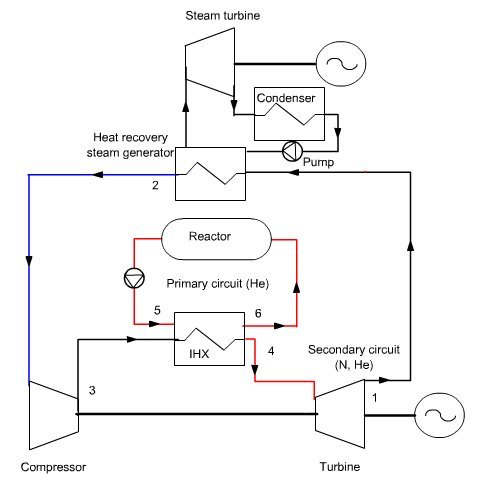
The gas circuit (a mixture of helium and nitrogen) is composed of a heat exchanger IHX that allows the transfer of energy from the coolant fluid (helium) warmed in the nuclear reactor core. A temperature difference of about 50 °C between the hot fl uid inlet and of cold fluid outlet is desirable to maintain the surface of this exchanger in a range of reasonable values.
Before passing through the exchanger IHX, the gas is first compressed by a compressor at a pressure between 55 and 70 bar, the latter value of 70 bar being a maximum value for reasons of strength of materials. At the exchanger outlet, the gas is expanded at about 40 bar in a turbine and exits at still relatively high temperature (about 600 °C). It is then cooled in a heat exchanger, and redirected to the compressor. The thermodynamic cycle selected utilizes the enthalpy available in this exchanger to operate a steam cycle and thereby obtain a combined cycle.
Gas temperature at the IHX heat exchanger inlet (thus at the compressor outlet) is 300 °C and pressure 55 bar. Gas temperature at the IHX exchanger outlet is 800 °C and pressure 55 bar. This results from a temperature differential of 50 °C selected on the IHX exchanger.
The proposed steam circuit consists of three successive turbines (high, intermediate and low pressure). Superheated steam available at the entrance of the HP turbine goes through an economizer that heats the liquid, a vaporizer that vaporizes it and a superheater. Two reheats are provided at the entrance of the IP and LP turbines.
Variations of this cycle adapted to CHP have also been optimized by Areva with Thermoptim (Figure below).
Dual pressure combined cycle combiné with helium Brayton cycle
To illustrate the usefulness of this type of cycle, let us start again from the example of PBMR helium cycle presented above, and build for this case a dual pressure combined cycle (120 and 10 bar, with HP and LP superheating at 500 and 300 °C). The synopsis of this optimized cycle, given in Figure below, shows that the efficiency rises from 48 to 52.5%.
Exercises and personal activities
An exercise is proposed to model the HTR cycle presented above. Its correction will provide the Thermoptim files allowing you to model the cycle presented above.
Références
V. DOSTAL, M.J. DRISCOLL, P. HEJZLAR, N.E. TODREAS, A Supercritical CO2 Gas Turbine Power Cycle For Next-Generation Nuclear Reactors, Proc. ICONE-10, Arlington, Virginia, April 14-18, 2003.
J. GOSSET, R. GICQUEL, M. LECOMTE, D. QUEIROS-CONDE, Optimal design of the structure and settings of nuclear HTR thermodynamic cycles, International Journal of Thermal Sciences, 44, 2005, pp. 1169-1179
P. PRADEL, La R&D sur les filières nucléaires actuelles et futures : enjeux et perspectives, Réalités Industrielles, Annales des Mines, ISSN 1148.7941, Fev. 2007, pp. 23-30.
P. F. PETERSON, Multiple-reheat Brayton cycles for nuclear power conversion with molten coolants, Nuclear Technology, Vol. 144, Numbre 3, Dec. 2003, pp. 279-288.
T. SCHULENBERG, H. WIDER, M. A. FÜTTERER, Electricity Production in Nuclear Power Plants – Rankine vs. Brayton Cycles, ANS/ENS International Winter Meeting (Global 2003), nov. 2003, New Orleans La, USA.
